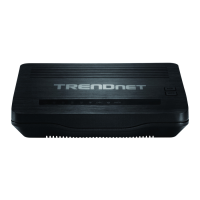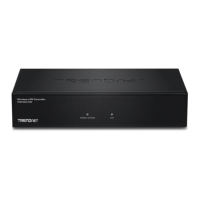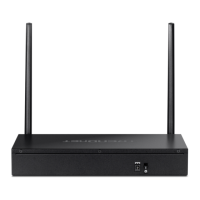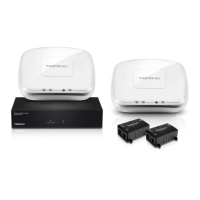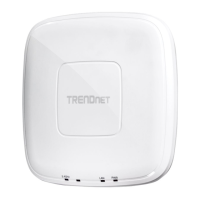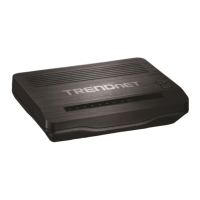© Copyright 2015 TRENDnet. All Rights Reserved.
Steps to improve wireless connectivity
There are a number of factors that can impact the range of wireless devices. Follow
these tips to help improve your wireless connectivity:
1. Keep the number of obstructions to a minimum. Each obstruction can reduce the
range of a wireless device. Position the wireless devices in a manner that will
minimize the amount of obstructions between them.
a. For the widest coverage area, install your router near the center of your home,
and near the ceiling, if possible.
b. Avoid placing the router on or near metal objects (such as file cabinets and metal
furniture), reflective surfaces (such as glass or mirrors), and masonry walls.
c. Any obstruction can weaken the wireless signal (even non-metallic objects), so
the fewer obstructions between the router and the wireless device, the better.
d. Place the router in a location away from other electronics, motors, and
fluorescent lighting.
e. Many environmental variables can affect the router’s performance, so if your
wireless signal is weak, place the router in several locations and test the signal
strength to determine the ideal position.
2. Building materials can have a large impact on your wireless signal. In an indoor
environment, try to position the wireless devices so that the signal passes through
less dense material such as dry wall. Dense materials like metal, solid wood, glass
or even furniture may block or degrade the signal.
3. Antenna orientation can also have a large impact on your wireless signal. Use the
wireless adapter’s site survey tool to determine the best antenna orientation for
your wireless devices.
4. Interference from devices that produce RF (radio frequency) noise can also impact
your signal. Position your wireless devices away from anything that generates RF
noise, such as microwaves, radios and baby monitors.
If possible, upgrade wireless network interfaces (such as wireless cards in computers)
from older wireless standards to 802.11n. If a wirelessly networked device uses an older
standard, the performance of the entire wireless network may be slower. If you are still
experiencing low or no signal consider repositioning the wireless devices or installing
additional access points.
Advanced wireless settings
Setup > Wireless Settings
The advanced wireless features can provide you with additional options for setting up
your wireless network such as multiple SSID, activate/deactivate wireless according to
schedule, and operation modes such as WDS (Wireless Distribution System) bridging or
wireless bridging.
Multiple SSID
Setup > Wireless Settings
The multiple SSID feature allows you to broadcast up to two additional SSIDs (or
wireless network names). To wireless devices searching for available wireless networks
to connect to, the SSIDs (or wireless network names) will appear as separate and
different wireless networks. Since they appear as separate wireless networks, they are
also referred to as virtual APs (Access Points). Each virtual AP can be configured each
with a different SSID (or wireless network name), security type and additional settings
for wireless devices to connect. You can use the multiple SSID feature to setup guest
wireless accounts with a different security type to keep your primary wireless network
security information private. In addition, the SSIDs can be mapped to a specified VLAN
ID. See the VLAN section for instructions on assigning VLAN IDs to the SSIDs.
1. Log into your router management page (see “Access your router management page”
on page 23).
2. Click on Advanced, and click on MBSSID.
3. Review the settings and click Apply to save settings.
Enable: Check box to enable SSID
SSID (VAP): Enter the SSID you would like to apply.

